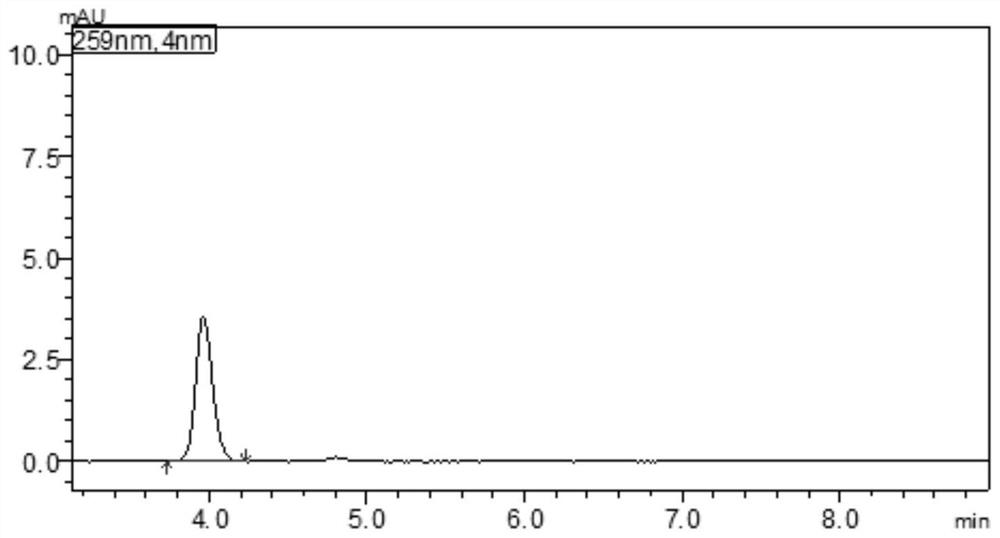Method for detecting 1,3-bis(1-isocyanate-1-methylethyl)benzene in adhesive through liquid chromatography
A technology of liquid chromatography and methyl ethyl, which is applied in the field of quality inspection, can solve the problems of rare reports on product residue detection, and achieve the effects of low detection limit, good precision, and small matrix interference
- Summary
- Abstract
- Description
- Claims
- Application Information
AI Technical Summary
Problems solved by technology
Method used
Image
Examples
Embodiment 1
[0052] A method for detecting 1,3-bis(1-isocyanato-1-methylethyl)benzene in an adhesive by liquid chromatography may further comprise the steps:
[0053] (1) Sample pretreatment
[0054] Weigh 1.0g±0.1g (accurate to 0.1mg) of a representative adhesive sample, put it into a 20mL brown sample bottle, add 10mL of dichloromethane and 200μL of derivatization reagent to it, and sonicate at room temperature for 40min; after the reaction Concentrate to dryness with nitrogen blowing, then add 10mL of derivative solvent, ultrasonically dissolve and filter through a 0.22μm filter membrane for on-machine measurement;
[0055] (2) Liquid chromatography detection
[0056] The sample solution is detected by a liquid chromatograph, and the chromatographic conditions are as follows:
[0057] Chromatographic column: ZORBAX SB-Aq (4.6*250mm, 5μm);
[0058] Injection volume: 10μL;
[0059] Column temperature: 40°C;
[0060] Mobile phase: use 20mM ammonium acetate solution as mobile phase A, ...
Embodiment 2
[0064] A method for liquid chromatography detection of 1,3-bis(1-isocyanato-1-methylethyl)benzene in adhesive, said method comprising the following steps:
[0065] (1) Sample pretreatment
[0066] Weigh 1.0g±0.1g (accurate to 0.1mg) of a representative adhesive sample, put it into a 20mL brown sample bottle, add 5mL of dichloromethane and 100μL of derivatization reagent to it, and ultrasonicate for 30min at room temperature; after the reaction Concentrate to dryness with nitrogen blowing, then add 10mL of derivative solvent, ultrasonically dissolve and filter through a 0.22μm filter membrane for on-machine measurement;
[0067] (2) Liquid chromatography detection
[0068] The sample solution is detected by a liquid chromatograph, and the chromatographic conditions are as follows:
[0069] Chromatographic column: ZORBAX SB-Aq (4.6*250mm, 5μm);
[0070] Injection volume: 2μL;
[0071] Column temperature: 40°C;
[0072] Mobile phase: use 5mM ammonium acetate solution as mobi...
Embodiment 3
[0076] A method for liquid chromatography detection of 1,3-bis(1-isocyanato-1-methylethyl)benzene in adhesive, said method comprising the following steps:
[0077] (1) Sample pretreatment
[0078] Weigh 1.0g±0.1g (accurate to 0.1mg) of a representative adhesive sample, put it into a 20mL brown sample bottle, add 15mL of dichloromethane and 300μL of derivatization reagent to it, and ultrasonicate for 60min at room temperature; after the reaction Concentrate to dryness with nitrogen blowing, then add 15mL of derivative solvent, ultrasonically dissolve and filter through a 0.22μm filter membrane for on-machine measurement;
[0079] (2) Liquid chromatography detection
[0080] The sample solution is detected by a liquid chromatograph, and the chromatographic conditions are as follows:
[0081] Chromatographic column: ZORBAX SB-Aq (4.6*250mm, 5μm);
[0082] Injection volume: 15μL;
[0083] Column temperature: 40°C;
[0084] Mobile phase: use 20mM ammonium acetate solution as m...
PUM
| Property | Measurement | Unit |
|---|---|---|
| pore size | aaaaa | aaaaa |
| correlation coefficient | aaaaa | aaaaa |
Abstract
Description
Claims
Application Information
 Login to View More
Login to View More - R&D
- Intellectual Property
- Life Sciences
- Materials
- Tech Scout
- Unparalleled Data Quality
- Higher Quality Content
- 60% Fewer Hallucinations
Browse by: Latest US Patents, China's latest patents, Technical Efficacy Thesaurus, Application Domain, Technology Topic, Popular Technical Reports.
© 2025 PatSnap. All rights reserved.Legal|Privacy policy|Modern Slavery Act Transparency Statement|Sitemap|About US| Contact US: help@patsnap.com



